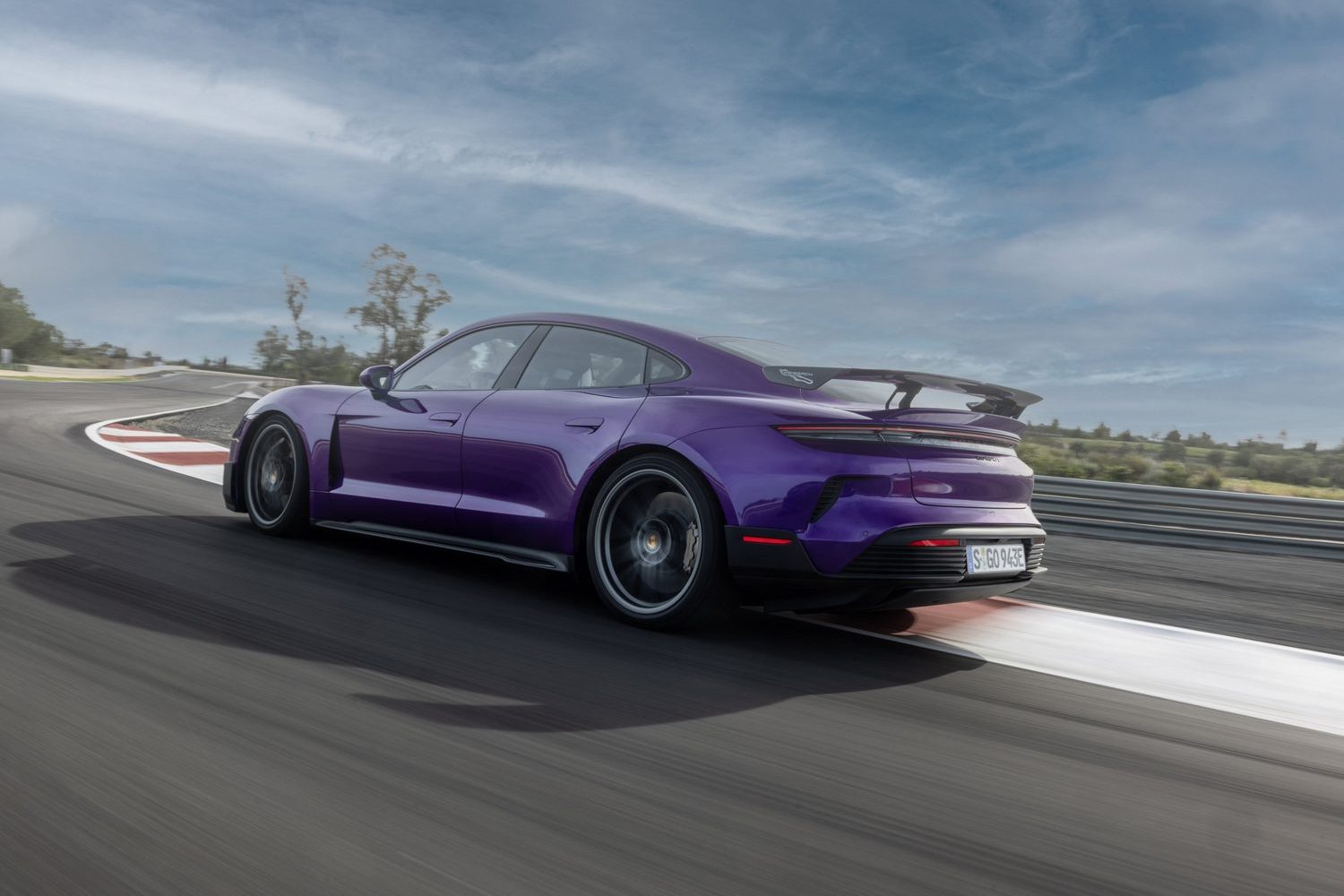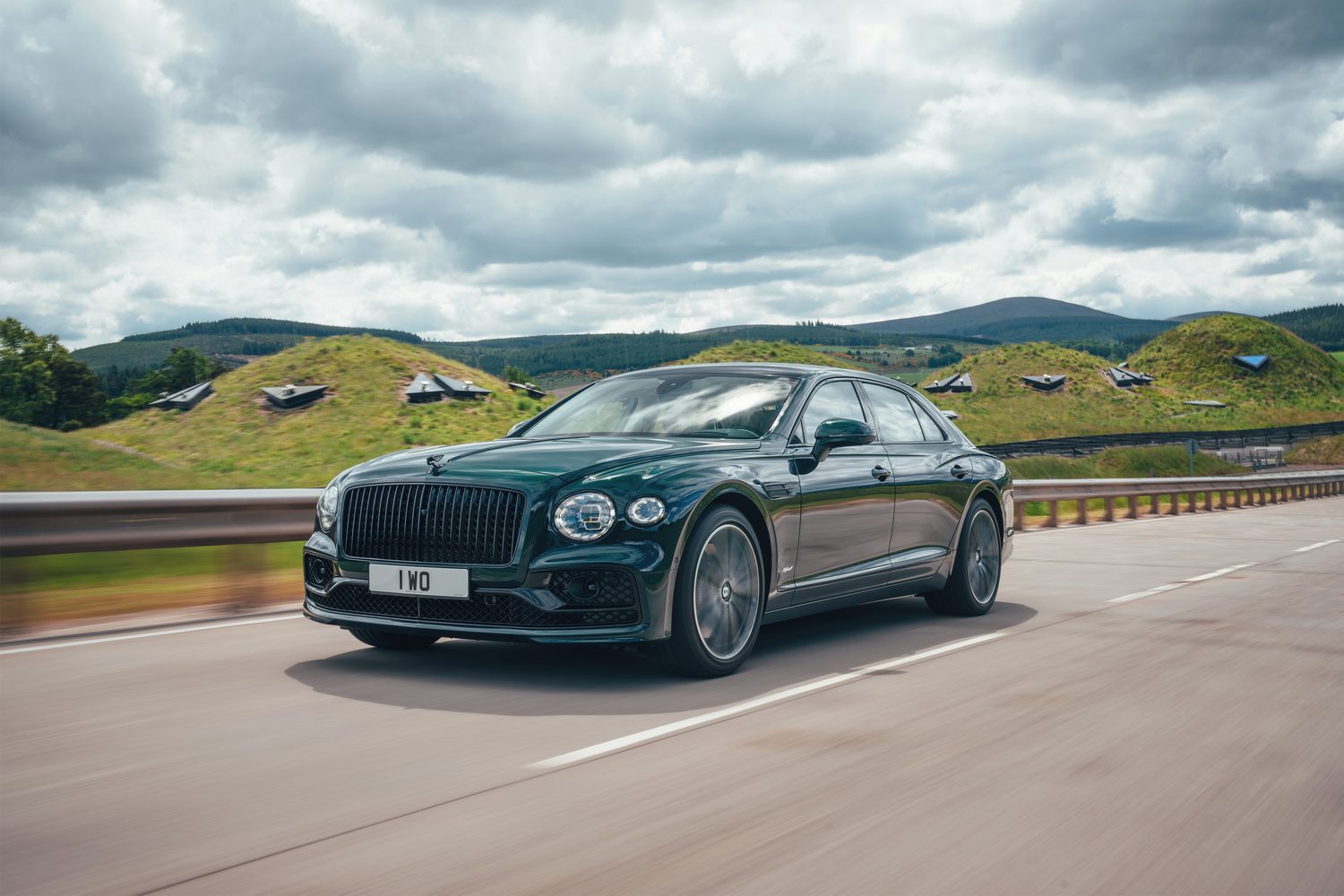Porsche takes its GT cars very seriously. In the company's eyes, those two letters represent the best of what it does with its road cars. With engineering input from its motorsport division, no scrap of performance is left on the table. For the first time, there is an electric GT model, and to say it packs some serious performance would be a considerable understatement. The Taycan Turbo GT is the most powerful series production Porsche yet.
In the metal
For 2024, the Porsche Taycan receives mild visual updates as part of greater enhancements beneath the bodywork. Entry-grade Taycan and Taycan 4S versions share a new front bumper design, featuring vertical inlets separate from the headlights, which have been reprofiled. From Taycan Turbo upwards, the front end gets a more technical look that can be further customised with alternative lower splitters.
The Taycan Turbo GT is a new addition to the line-up and is distinguished by several unique details. It gets a bespoke front bumper with carbon fibre 'aeroblades' at each end to channel airflow around the front wheels and down along the car's sides. Combined with a redesigned underbody, these contribute to up to 220kg of downforce. Part of that downforce is produced at the rear thanks to an adaptive spoiler with a 'Gurney flap' finished in high gloss carbon fibre.
New LED matrix headlights are a standard item on the Taycan Turbo GT, and buyers can optionally add the HD matrix LED headlights at no additional cost, though these weigh slightly more.

The Weissach package is a familiar option for Porsche's GT cars, designed for those who crave a more overtly sporting look. As part of this, the adjustable lip spoiler is replaced by a fixed rear wing made of carbon fibre, complete with the Weissach logo on the end plates.
Weight saving is one of the main reasons for choosing the Weissach package, and Porsche hasn't been subtle in its efforts to do so. One of the Taycan's usual two charge ports has been deleted, leaving only the CCS port on the front right; even that loses the electric motor that would operate the charge port cover.

In the four-door Taycan, weight saving includes the deletion of the rear seats. In their place is a finely crafted carbon fibre panel with built-in storage that can accommodate a couple of soft weekend bags beneath a fabric cover that buttons down.
Losing the rear seats, along with the other measures, results in a weight saving of around 70kg compared to the non-GT Turbo. Weight aside, this makes the Taycan a far less practical car, though Porsche aficionados will undoubtedly covet the Weissach package's raw, stripped-out aesthetic.
Driving it
The Taycan had already earned its stripes as a high-performance electric car, but what Porsche has been able to achieve with the Turbo GT redefines that term. On paper, this battery-powered saloon has a set of numbers capable of winning almost any Top Trumps game while simultaneously embarrassing most supercars. The Turbo GT moves the Taycan range into hypercar territory.
Sliding into the carbon-backed bucket seats makes you momentarily forget that there are two doors, one very elaborate storage box and a boot behind you. The seats are a relatively firm reminder that you're not sitting in any old Porsche. Comfort isn't completely forgotten about, though, as Porsche's 18-way electrically adjustable 'Sports Seats Plus' are available as a no-cost option - but they're not going to fit in quite as well with the spartan Weissach package. The GT Sports steering wheel wrapped in Race-Tex feels divine and is perfectly sized and shaped. Every other part of the cabin is finished to a typically high standard, as one would expect from Porsche.

Much has been done to futureproof the Taycan for the coming years, and that's especially true with the battery. An improved 97kWh unit has higher usable energy capacity, boosting the WLTP range to 555 kilometres. The charging performance also receives a notable upgrade. Peak DC charging is now 320kW, and the battery can maintain more than 300kW for up to five minutes, shaving minutes from the amount of time you need to be plugged in.
When it comes to exploiting all that stored energy, the Taycan Turbo GT faces few rivals. Even in its standard mode, the dual-motor setup produces 789hp, but it's when utilising the overboost power with launch control that it becomes genuinely extraordinary. Turn the circular drive mode dial through its wonderfully mechanical indents to Sport Plus, firmly press the brake pedal with your left foot and then plant the accelerator pedal all the way down. Little prepares you for the first time the Taycan Turbo GT launches.

Dump the brake pedal, and your head snaps back against the seat with the sort of accelerative force you imagine a fighter pilot might experience when launched off an aircraft carrier. The digital speedo needs help to keep up. From its standing start, the 100km/h barrier is surpassed in just 2.2 seconds. That's quicker than it takes to read that sentence. But the second phase of the launch really gets you: the way it pulls from 100km/h to 200km/h as you start to feel like your insides are being rearranged while your head remains pinned to the seat is astounding. Much of that is down to the phenomenal 1,340Nm of instant torque delivery that slingshots the 2,220kg saloon towards the horizon. After only a couple of these starts, a feeling of nausea overcomes most people.
There's a whole lot more to this car's repertoire than stomach-churning launches. Taking the Taycan's push-to-pass feature one step further, the Turbo GT has what Porsche calls Attack Mode. Pulling on the paddle on the right side of the wheel delivers a 120kW kick in the back that lasts for up to 10 seconds (or until you lift off the accelerator - or pull the paddle again), and it is a very noticeable bump in power when you're already on it. This Porsche is computer game fast on track, even before dipping into Attack Mode.
A big part of what makes it feel so capable is the trick Porsche Active Ride suspension, which sometimes works in otherworldly ways. This adaptive air suspension is available on other Taycans and Panameras, but is standard fitment on the Turbo GT. Through bends, the suspension eradicates any semblance of body roll, and the same is true for pitch and dive under braking.

In its more aggressive setting, the suspension can counteract the forces that apply to cars, leaning into a corner rather than rolling to the outer side and reducing lift at the rear axle under the heaviest of braking. It feels bizarre initially, but once you learn to work with the system and understand how it's there to help, the results can make any keen driver feel superhuman.
Along with all that performance and supreme ride quality is a steering setup that is simply sublime, completing a trifecta of the very latest in modern car performance. Rear axle steering and the Power Steering Plus setup result in HD-levels of feedback through the wheel, making you feel fully connected with the car and not as if you're just along for the ride.
What you get for your money
There's quite the price walk from where the Taycan range starts (at €110,446) to the Turbo GT, which will set you back some €266,024, and that's before you start adding options. Anything beyond the four standard colour hues will cost another €3,327 or if you're feeling more creative, the Paint to Sample palette colours cost €9,181.
The panoramic roof with variable light control is available for €4,783, and it is quite a neat feature. What does stick slightly in the throat are the features in this range-topper that you'll still need to pay extra for: adaptive cruise control will set you back a further €1,330, while InnoDrive with Active Lane Keeping is €2,487.
Summary

It's hard to wrap your head around just what Porsche's engineers have been able to create in the Taycan Turbo GT. Descriptors for the performance range from silly to outrageous, and when you take a step back and consider that this is a series production car that anyone (with sufficient funds) can walk in and buy, it makes you wonder where the performance EV game will be in another five or ten years. If you still think that electric cars can't be "drivers' cars", you need to drive this, because little else will give you the same brain-scrambling performance for the price.



























